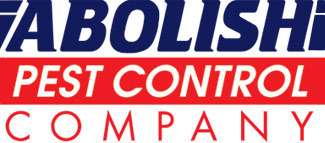Call toll free 877-4ABOLISH
877-422-6547
Household Crawling Insect Pests
| Gallery | Crawling Insects | Flying Insects |
A common pest control service we offer is for inside and outside sprays. There are a vast array of pest insects to defend against including ants, cockroaches, flying insects, fleas, spiders, and other crawling invaders. Different pests require different techniques and chemicals, all technicians are certified and are constantly trained in all aspects of pest control and chemical usage.
Our services we provide.
First you must narrow down your pest problem to a single category. Once you have a general idea choose one of the following services below for more info, facts, and services.
Crawling Insects
Ant
 House ant
House ant
Family Formiciadae
A wide variety of species are found throughout North America. Most feed on organic matter and are especially attracted by sweet foods. Colonies hibernate in the soil or in garden trash.
Distinguishing characteristics:
Although there are many different species of common house ants, most are black, brown or reddish in color. They range from 1/6” to ¼” in length with an enlarged abdomen. May be winged or wingless.
Control Method :
Eliminating any access to food source and targeting the the main and satellite nests.
Cockroach
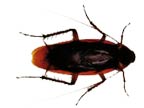 American cockroach
American cockroach
Periplaneta Americana
Found in dark, moist areas such as around bathtubs, clothes hampers, sewers and basement corners. Also, wherever food is prepared and stored.
Distinguishing characteristics:
The largest of the common species, growing to a length of 1 ½” or more. Reddish-brown with a yellow border on the back of the pronotum. The wings of the male extend beyond the tip of the abdomen, while the female’s wings are about the same length as the abdomen.
Control Method :
Cockroach
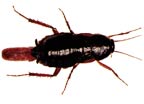 Oriental cockroach
Oriental cockroach
Blatta orientalis
Found in all parts of the United States. They’re most common in high moisture situations, especially around decaying organic matter. Most common in late spring or early summer.
Distinguishing characteristics:
Very dark brown or black. Male is about 1 ¼” long while the female reaches only 1” in length. The female has functionless wing stubs. The male’s wings cover about ¾ of the abdomen. Neither sec flies. Females are broader and heavier.
Control Method :
Cockroach
 German cockroach
German cockroach
Blatella germanica
The most common roach in United States homes. Breeds throughout the year. Favors humid atmosphere and an average temperature of 70 degrees.
Distinguishing characteristics:
Adults are about ½” long, brown with two dark streaks on the thorax. The female is darker in color with a broader, more rounded posterior. Both sexes have wings as long as their bodies.
Control Method :
Flea
 Cat flea
Cat flea
Ctenocephalides felis
Most common during the summer, especially when homes are reoccupied after vacation. Most common hosts are cats, dogs, man and a wide variety of animals.
Distinguishing characteristics:
Fleas are extremely small, averaging 2 to 4 mm in length. The body is flattened vertically and is covered with spines which project backward. They are wingless but have long, powerful legs for jumping great distances.
Control Method :
Pillbug
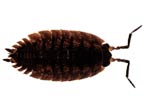 Sowbugs & Pillbugs
Sowbugs & Pillbugs
Class Crustacea
They prefer moist locations and can be found under vegetable debris or any object on damp ground. Frequently invade damp basements, crawl spaces and may infest potted plants
Distinguishing characteristics:
Oval bodies, convex above and flat or hollow underneath. Never over ¾” long. Both have seven pairs of legs. The sowbug has two tail-like appendages that prevent it from rolling up in a ball. The pillbug, however, lacks these appendages and rolls itself into a tight ball.
Control Method :
Tick
 Brown dog tick
Brown dog tick
Rhipicephalus sanguineus
Found most often in the ear, between the toes and on the back of dogs. After feeding they retire to baseboards, molding, around window-cord pullets, any protected openings.
Distinguishing characteristics:
Adults are flat, about 1/8” long and uniformly red-brown with tiny pits scattered over the back. Unlike the male, the female enlarges after feeding to about ½” long and ¼” wide. The enlarged portion of the body becomes gray-blue to olive in color.
Control Method :
Silver Fish
 Silverfish & Firebrats
Silverfish & Firebrats
Order Thysanura
Family Lepismatidae
Among the most common insect in the home. They eat paper, fabrics and get into cereals. Firebrats prefer temperatures over 90 degrees and are usually not found together with silverfish.
Distinguishing characteristics:
Bodies are long, slender and flattened; broad at the front and tapering to the rear. Antennae are long and slender. Three long, slender appendages protrude from the rear. They’re wingless and the body is about ½” long.
Control Method :
Beetle
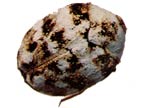 Carpet beetle
Carpet beetle
Anthrenus
Scrophulariae
Most common in northern states. This beetle infests carpets and feeds on the fabric. It also feeds on animal products that are left undisturbed such as wool, leather, furs, etc.
Distinguishing characteristics:
These beetles are small and oval in shape. They’re grayish black in color with a varied pattern of white and orange scales on the back. An orange-red band of scales runs down the middle of the back.
Control Method :
Centipede
 Centipede
Centipede
Class Chilopoda
Found throughout the country. House centipedes live in damp areas such as cellars, closets, bathrooms. Outdoors they can be found in damp locations, under leaves and stones, etc.
Distinguishing characteristics:
A flat wormlike body, 1” or more in length with one pair of long legs or almost each body segment. The house centipede is grayish-yellow with three dark stripes running the length of the body. It has 15 pairs of legs with hind legs more than twice its body length.
Control Method :
Earwig
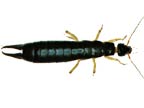 Earwigs
Earwigs
Order dermaptera
Earwigs are active at night and hide in cracks or underneath objects during the day. Most species scavenge on dead animal and plant material. Eggs are laid in underground burrows.
Distinguishing characteristics:
Earwigs are most readily recognized by the forceps at the end of the abdomen. Species range from ½” to 1” in length, and from light reddish-brown to jet black in color. Some species are marked with stripe or bands on the body and legs.
Control Method :
Flying Insects
Honey Bee
 Honey bee
Honey bee
Apis mellifera
The European Honey bees are active during the day, foragers spend most of the day collecting pollen. Most species rely on nectar from flowers for food.. Eggs are laid in wax-based honeycombs.
Distinguishing characteristics:
Honey Bees are most readily recognized by their color of amber to brown translucent alternating with black stripes. Honey Bees are usually about 1/2" in length. The stinger is barbed and continues to pump venom once it tears from the bee which kills the bee.
Control Method :
Wasp
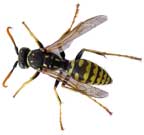 Wasps
Wasps
Order Hymenoptera
More aggressive than honeybees and can be a pest when they
Distinguishing characteristics:
longer than honey bees. Abdomen is usually larger and legs longer. Unlike the honeybee, wasps can sting several times.
Control Method :
Yellow Jacket
 Yellow Jacket
Yellow Jacket
Order Hymenoptera
Family Vespidae
Most species scavenge on dead animal and plant material. Eggs are laid in underground burrows.
Distinguishing characteristics:
Species range from ½” to 1” in length, and from yellow to jet black in color. Some species are marked with stripe or bands on the body.
Control Method :
House Fly
 House Fly
House Fly
Family Musca Domestica
One of the most widely distributed insects; it is a pest that carries and transmits serious diseases. Severe house fly infestations should be treated immediately for human health safety concerns.
Distinguishing characteristics:
The adults are 6-9 mm long. Their thorax is gray, with four dark longitudinal dark lines on the back, the underside of their abdomen is yellow, and their whole body is covered with hair. The females are slightly larger than the males and have a much larger space between their red compound eyes.
Control Method :
Mosquito
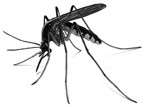 Mosquito
Mosquito
Diptera Culicidae
Mosquitoes, their eggs, and larvae, can be found in and around stagnent water. The best way to prevent mosquitoes from breeding and populating around your home would be to, of course, remove any stagnant water. Southern California sees less mosquitoes during dry weather seasons compared to wet humid areas in the US, but they are still present and can spread such diseases as encephalitis virus or the west nile virus.
Distinguishing characteristics:
Mosquitoes life cycle goes through 4 stages and spotting them in any one of these stages can help in controlling them. The stages are egg, larva, pupa, and adult. The first three stages all remain in the same stagant water from when the eggs were laid.
Beware: There are many products and gimmicks that are advertised to remove and keep birds away. If you don't know what your doing or fall for an unreliable product you may be wasting your money. We have pictures of examples of how inexperience and faulty products can make a problem worse.
